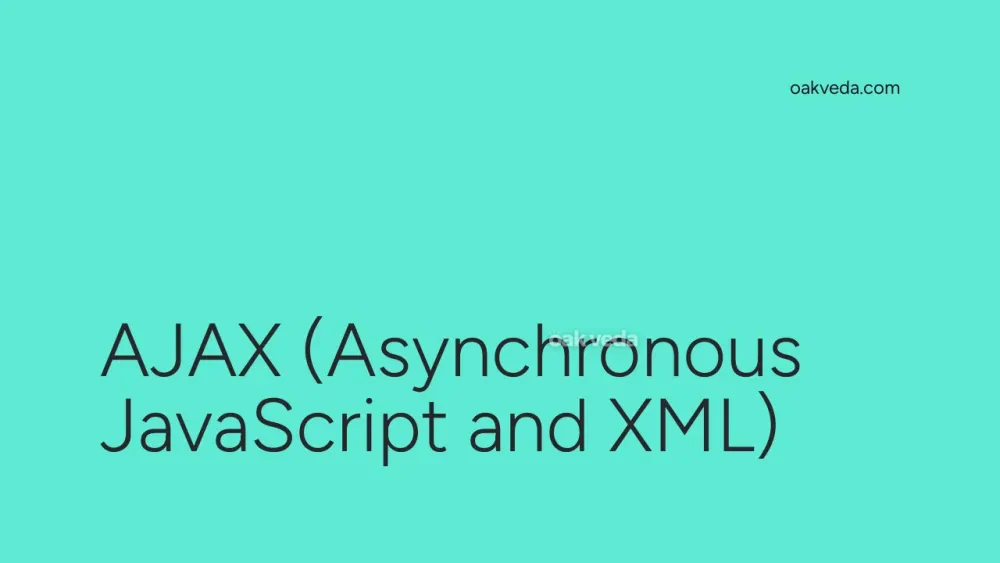
What is the Full Form of AJAX?
AJAX is the acronym for Asynchronous JavaScript and XML. This powerful web development technique has revolutionized the way we interact with websites, making them more dynamic and responsive.
What is Asynchronous JavaScript and XML?
Asynchronous JavaScript and XML, commonly known as AJAX, is not a single technology but rather a combination of several web technologies used to create fast and interactive web applications. Despite its name, AJAX doesn't necessarily use XML; it can work with various data formats, including JSON, HTML, and plain text.
Origin and Development of AJAX
The concept of AJAX has its roots in the late 1990s, but it wasn't until 2005 that it gained widespread recognition:
- 1996: Microsoft introduced the IFrame tag in Internet Explorer, allowing partial page updates.
- 1999: Microsoft created the XMLHTTP ActiveX control, a precursor to modern AJAX techniques.
- 2005: Jesse James Garrett coined the term "AJAX" in his article "Ajax: A New Approach to Web Applications."
- 2006: Google popularized AJAX with applications like Gmail and Google Maps.
Since then, AJAX has become an integral part of modern web development, continuously evolving with new frameworks and libraries.
How does AJAX work?
AJAX operates by allowing web pages to update content asynchronously without reloading the entire page. Here's a simplified explanation of the AJAX process:
- An event occurs in a web page (e.g., a button click).
- JavaScript creates an XMLHttpRequest object.
- The XMLHttpRequest object sends a request to the server.
- The server processes the request.
- The server sends a response back to the browser.
- JavaScript reads the response.
- JavaScript updates the page content accordingly.
This process happens behind the scenes, providing a seamless user experience.
Functions of AJAX
AJAX serves several crucial functions in web development:
- Asynchronous Communication: Enables client-server communication without page reloads.
- Partial Page Updates: Allows updating specific parts of a web page without refreshing the entire content.
- Enhanced User Experience: Provides a more responsive and interactive interface.
- Reduced Server Load: Minimizes data transfer by requesting only necessary information.
- Real-time Data Handling: Facilitates live updates and real-time data processing.
Applications of AJAX
AJAX has found its way into numerous web applications and features:
- Auto-complete: Suggests search terms as users type.
- Form Validation: Checks form inputs in real-time without submitting the form.
- Infinite Scrolling: Loads more content as users scroll down a page.
- Live Updates: Displays real-time information like stock prices or social media feeds.
- Single-Page Applications (SPAs): Powers modern web apps that function like desktop applications.
Features of AJAX
Key features that make AJAX a popular choice among developers include:
- Asynchronous Processing: Allows multiple requests to be sent and processed simultaneously.
- Browser Independence: Works across different browsers and platforms.
- Data Format Flexibility: Supports various data formats, including JSON, XML, and plain text.
- Improved Performance: Reduces server load and enhances application speed.
- Better User Interface: Enables smoother, more responsive user interactions.
Benefits of AJAX
Implementing AJAX in web applications offers several advantages:
- Enhanced User Experience: Provides a smoother, more desktop-like experience.
- Faster Page Loads: Reduces the amount of data transferred between client and server.
- Reduced Server Load: Minimizes full page reloads, decreasing server resource usage.
- Improved Responsiveness: Allows for quicker updates and interactions.
- Better Interactivity: Enables more dynamic and engaging web applications.
Limitations or Challenges of AJAX
While AJAX offers numerous benefits, it also comes with some limitations:
- Browser Compatibility: Older browsers may not fully support AJAX functionality.
- Search Engine Optimization (SEO): Dynamic content can be challenging for search engines to index.
- Accessibility Issues: Some screen readers may struggle with dynamically updated content.
- Back Button Functionality: AJAX updates don't change the URL, potentially breaking the browser's back button.
- Increased Complexity: AJAX can make debugging and maintaining code more challenging.
Future Developments in AJAX Technology
As web technologies continue to evolve, so does AJAX:
- Progressive Web Apps (PWAs): AJAX plays a crucial role in creating offline-capable web applications.
- WebSockets: Real-time, bidirectional communication is becoming more prevalent, complementing AJAX.
- GraphQL: This query language for APIs is gaining popularity, offering more efficient data fetching.
- Serverless Architecture: AJAX is adapting to work with serverless functions and microservices.
- AI Integration: AJAX is being used to integrate AI-powered features into web applications.
FAQs on AJAX Full Form
-
Is XML necessary for AJAX? No, despite the "X" in AJAX standing for XML, modern AJAX applications often use JSON instead of XML for data transfer.
-
Can AJAX work without JavaScript? No, JavaScript is essential for AJAX as it handles the asynchronous communication with the server.
-
Is AJAX a programming language? No, AJAX is not a programming language but a technique that uses existing technologies like JavaScript and XML/JSON.
-
Does AJAX require a specific server-side technology? No, AJAX can work with any server-side technology that can process HTTP requests and send responses.
-
Is AJAX still relevant in modern web development? Yes, while newer technologies have emerged, AJAX remains a fundamental technique in creating interactive web applications.
In conclusion, AJAX, or Asynchronous JavaScript and XML, has significantly impacted web development since its introduction. By enabling asynchronous communication between the browser and server, AJAX has paved the way for more dynamic, responsive, and user-friendly web applications. Despite some limitations, its benefits continue to make it a valuable tool in the modern web developer's toolkit.
You may be interested in:
- ICICI (Full Form): Industrial Credit and Investment Corporation of India
- LLP (Limited Liability Partnership) Full Form
- CSS (Cascading Style Sheets): Full Form and Guide
- OPD (Outpatient Department): Full Form and Functions
- CAIIB (Certified Associate of Indian Institute of Bankers)
- HSC (Higher Secondary School Certificate) Full Form

